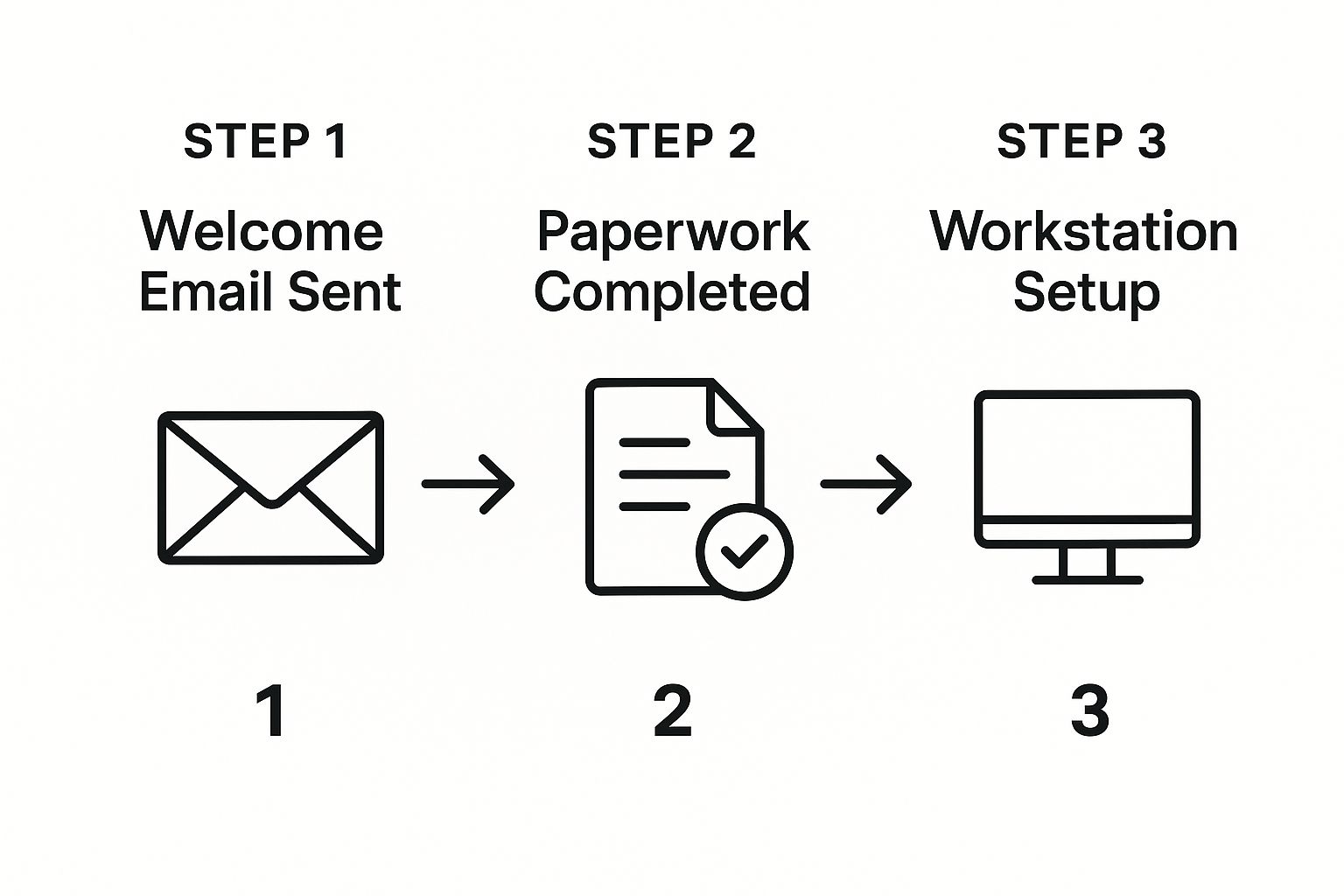Picture two completely different first days at a new job. In one scenario, you're dumped at an empty desk with a password that doesn't work and no idea who to ask for help. In the other, your laptop is set up, a welcome kit is waiting, and a team lunch is already on your calendar.
That difference is a well-designed onboarding program. It’s so much more than a warm welcome—it's a critical business strategy.
Why Great Onboarding Is a Business Imperative
Let's look past the HR checklist for a moment and talk about why onboarding is a core driver of business success. Think of it not as an administrative chore, but as the first real investment you make in your most valuable asset: your people.
A chaotic, unstructured welcome sends a clear message that the company is disorganized and, frankly, that the new hire isn't a priority. That initial impression is incredibly difficult to shake.
On the flip side, a smooth, structured experience sets the stage for long-term engagement and productivity. It takes a new hire’s initial excitement and turns it into genuine commitment. More than just making people feel welcome, great onboarding is a powerful tool for reducing employee turnover and retaining top talent. When employees feel supported and equipped from day one, they integrate faster, contribute more meaningfully, and become advocates for your company.
The Financial and Cultural Impact of Onboarding
The data tells a very clear story here. Effective onboarding programs have a direct, measurable impact on employee satisfaction and the bottom line. Research shows employees who have a positive onboarding experience are 2.6 times more likely to be happy with their jobs.
Yet, there's a huge gap between what works and what companies actually do. A staggering 12% of employees report that their company does a good job with onboarding.
This disconnect has real consequences. Companies that invest in a strong onboarding process see a remarkable difference. For instance, 69% of employees who go through an exceptional process are likely to stick around for at least three years, which is a massive factor in cutting down expensive turnover.
The economic benefits are just as compelling. Firms with robust programs achieve 2.5 times the revenue growth and 1.5 times the profit growth of their peers. You can dig into more of the research behind these powerful employee onboarding statistics.
The takeaway is simple: Onboarding isn't a cost center. It's a revenue-generating, culture-building investment that pays dividends through higher retention, productivity, and profitability.
To build a program that actually delivers these results, you need a framework grounded in clear objectives. We can break down any world-class onboarding process into four essential pillars, each designed to address a different part of a new hire's journey.
The Four Pillars of Effective Onboarding
Think of these pillars as the foundation of your entire onboarding house. If one is weak, the whole structure becomes unstable. A great program systematically addresses each of these areas to create a truly comprehensive experience.
| Pillar | Objective | Key Activities |
|---|---|---|
| Compliance | To cover all necessary legal and policy-related requirements efficiently. | Completing payroll forms, signing NDAs, reviewing the employee handbook. |
| Clarification | To ensure the new hire fully understands their role and expectations. | Reviewing the job description, setting 30-60-90 day goals, team introductions. |
| Culture | To immerse the new hire in the company's values and social norms. | Team lunches, company history overview, assigning an onboarding buddy. |
| Connection | To build the interpersonal relationships needed for success. | One-on-one meetings with managers, cross-departmental introductions. |
Mastering these four pillars ensures you're not just checking boxes but are actively setting your new team members up for long-term success from their very first day.
Designing Your Structured Onboarding Framework
Throwing a new hire into their role without a plan is a recipe for disaster. It's like handing them a box of IKEA furniture parts with no instructions—they might piece something together eventually, but it's going to be slow, frustrating, and probably wobbly. A structured onboarding framework is those instructions. It provides a clear, repeatable roadmap that guides a new person from day-one uncertainty to genuine confidence.
Building this kind of system is one of the most important things you can do. It makes sure every single person who joins your company gets the same high-quality, welcoming experience, no matter their department or manager. It’s not just about ticking boxes; it’s about creating a predictable journey that helps them become productive members of the team, fast.
The Pre-Boarding Phase: What Happens Before Day One
The onboarding experience doesn't start on the first day; it starts the second a candidate says "yes" to your offer. This "pre-boarding" window is your golden opportunity to make them feel great about their decision. The goal here is simple: get the boring administrative stuff out of the way early and start making them feel like part of the team before they even set foot in the office.
This all comes down to proactive communication. Think about the difference a welcome email from their future manager makes, or getting a clear schedule for their first day. It transforms those first-day nerves into real excitement and sends a clear message: "We're ready for you, and we can't wait for you to start."
Here are a few simple but powerful steps you can take during this critical pre-boarding phase.

Nailing these small details from the get-go shows you're organized and that you genuinely care.
The First Week: Immersion and Connection
The first week needs to be a thoughtfully planned mix of learning, meeting people, and getting oriented. Yes, there will be some paperwork, but the real focus should be on immersing the new hire in your company culture and helping them build those crucial first relationships.
A structured onboarding process is proven to be a powerhouse for talent retention and productivity. Organizations with standard programs boost new hire retention by 82% and see a 50% increase in new hire productivity.
Those numbers really drive home why a single day of orientation just doesn't cut it anymore. A solid employee transition plan template can provide the roadmap you need.
Here’s what a great first-week checklist should include:
- Manager One-on-One: A dedicated meeting to walk through their role, talk about a 30-60-90 day plan, and set clear initial expectations.
- Team Introductions: Go beyond just names. Set up quick chats so they can learn what everyone on the team actually does.
- Tech and Tools Setup: Make sure they have access to every account and all the software they need, with someone on standby to help troubleshoot.
- An Early Win: Give them a small, manageable task they can complete. Letting them contribute something tangible in their first few days is a huge confidence booster.
The First Month: Building Momentum
Once the whirlwind of the first week is over, the next month is all about building on that foundation. The focus shifts from general company information to specific, role-based training. This is the perfect time to blend self-guided learning with more hands-on, interactive sessions.
Consistent check-ins are absolutely vital during this stage. Quick, informal chats with their manager or an assigned onboarding buddy can catch any roadblocks or confusion early on. The goal is to make sure they aren't just treading water, but are actively learning and starting to feel comfortable in their new role.
The First 90 Days: Driving Performance
By the end of the first 90 days, a new hire should be shifting from learning mode to performing mode. At this point, they should have a firm handle on their responsibilities, be fitting in well with the team, and understand how their day-to-day work connects to the bigger company goals.
The 90-day mark is a natural milestone. It’s the perfect time for a more formal check-in to see how they're tracking against their initial goals, ask for feedback on the onboarding process itself, and set clear objectives for the coming quarter. This conversation officially marks their transition from "the new person" to a fully integrated, productive member of the team.
High-Impact Onboarding Practices to Implement Now

A solid framework gives you the skeleton, but the real magic happens in the details. It's the specific, thoughtful practices you put in place that bring your onboarding to life. Let's move from theory to action and look at the tactics that turn a good process into a truly great one.
Think of it like this: your framework is the recipe, but these practices are the high-quality ingredients and expert cooking techniques that make the meal unforgettable. These are the moves that make new hires feel supported, connected, and ready to make a real impact from day one.
Assign an Onboarding Buddy
Starting a new job can feel like the first day of school all over again. It’s easy to feel lost, especially when you have simple, practical questions you don't want to bother your manager with. Enter the onboarding buddy. This is a friendly, approachable peer who acts as a new hire's go-to resource for their first few weeks.
This person isn't a boss or a formal mentor; they're a cultural guide. They answer the questions that aren't in the handbook, like, "What's the trick to booking a meeting room?" or "Which Slack channels are actually important?" It's a simple practice designed to create an immediate human connection and make the new environment feel far less intimidating.
Why It Works: We know from research that employees who have a "best friend" at work are more engaged and stick around longer. A buddy system kickstarts this process. It gives the new hire a friendly face and a trusted contact right away, which is priceless for cutting through that initial feeling of isolation.
Create a 30-60-90 Day Plan
One of the biggest culprits of new-hire anxiety is uncertainty. A 30-60-90 day plan is the perfect antidote, replacing that ambiguity with a clear, actionable roadmap. This document lays out specific goals, learning objectives, and key milestones for their first three months.
This isn't just a to-do list; it's a shared agreement that ensures the new hire's efforts are perfectly aligned with what the team and company need.
- First 30 Days: The focus here is on learning and getting settled. This means completing essential training, meeting key people, and getting a feel for the company culture and tools.
- Next 60 Days: The new hire starts shifting from learning to contributing. They might begin to take the lead on smaller projects and collaborate more deeply with their colleagues.
- By 90 Days: The goal is for the employee to be mostly self-sufficient, handling the core parts of their role with confidence. They should be working with their manager to set their own goals.
This structured approach provides incredible clarity and helps both the new hire and their manager see and track progress. You can explore how this fits into the bigger picture in our complete guide to SaaS onboarding best practices.
Engineer Early Wins
Momentum is a powerful psychological tool. Nothing builds a person's confidence faster than getting something done and doing it well. Instead of dropping a new hire into a massive, complex project, you need to engineer an early win. Give them a small, self-contained task they can successfully complete within their first week.
This could be as simple as fixing a minor bug, writing a short internal document, or finishing a specific piece of customer research. It just has to be a real task with a clear finish line.
How to Implement It:
- Find a small, low-risk task that directly relates to their role.
- Provide crystal-clear instructions and make sure they have everything they need.
- Offer your support, but let them own it from start to finish.
- Acknowledge their work publicly in a team meeting or a Slack channel.
That small victory delivers a huge confidence boost, shows the team they're already adding value, and creates positive momentum that will carry them through bigger challenges down the road.
Establish Strong Feedback Loops
Onboarding can't be a one-way street. While you're busy giving information to the new hire, you have to be just as active in getting feedback from them. This is where regular, informal check-ins become absolutely critical.
These aren't formal performance reviews. They're quick, casual conversations to ask things like:
- "How are you feeling about everything so far?"
- "Is anything still unclear or confusing?"
- "Do you have everything you need to do your job well?"
Schedule these check-ins frequently at the beginning. A quick 15-minute chat at the end of their first day, another at the end of the first week, and then weekly for the first month is a great rhythm. This open dialogue helps you catch potential problems early and, just as importantly, shows the new hire that you genuinely value their experience and perspective.
Adapting Onboarding for Remote and Hybrid Teams

The rise of distributed work isn't just a trend; it's permanently rewired how teams collaborate. This shift means we can no longer rely on the natural "osmosis" of company culture that happens when everyone shares a physical office. To successfully welcome remote and hybrid employees, we have to be much more intentional about bridging the distance and making them feel like they truly belong from day one.
If you don't adapt your onboarding process, new remote hires can feel disconnected and left behind. In fact, a staggering 63% of remote workers report feeling undertrained after their onboarding wraps up. The key is to deliberately recreate the support and camaraderie that in-office employees get automatically, ensuring everyone starts on a level playing field.
Creating Connection Before Day One
For remote hires, the pre-boarding phase is more critical than ever. There’s no office tour or welcome lunch to look forward to, so the period between accepting the offer and their first day is your best chance to build excitement.
One of the most powerful things you can do is ship a "welcome kit" right to their doorstep. It’s a simple gesture, but this tangible package makes the job feel real and proves you’re invested in their journey.
A truly great welcome kit often includes:
- Essential Equipment: A pre-configured laptop, monitor, and any other hardware they need to hit the ground running.
- Company Swag: A branded hoodie, water bottle, or notebook does wonders for building a sense of identity and team pride.
- A Personal Touch: You can't underestimate the impact of a simple, handwritten welcome note from their direct manager.
This first impression can transform a new hire's first-day jitters into genuine enthusiasm for the role ahead.
Fostering Culture and Community Virtually
Without the spontaneous hallway chats or coffee runs, building those informal social bonds requires a conscious effort. You have to purposefully create opportunities for the interactions that would otherwise happen organically in an office setting. This is where a smart mix of technology and thoughtful planning comes into play.
Your communication tools are your best friend here. Set up dedicated Slack or Teams channels where new hires can ask questions and connect with their cohort. A virtual "watercooler" channel dedicated to non-work topics can also help replicate that casual office banter. Of course, using video calls for introductions, team meetings, and one-on-ones is non-negotiable for putting faces to names and building real rapport.
The goal is to ensure a remote employee’s experience isn't just a series of tasks and video calls. It’s about building a network of support and immersing them in the company culture, no matter where they are.
Getting this right involves careful planning. You can draw inspiration from great onboarding UX design, which prioritizes clarity and a positive user experience.
Adapting Key Onboarding Activities
Many of our tried-and-true onboarding rituals need a digital-first makeover. The core goals—covering compliance, clarifying roles, immersing in culture, and building connections—are all still the same. It's the how that needs to change for a distributed workforce. If you're interested in the bigger picture, there are some great strategies for managing remote teams effectively that are worth exploring.
To make this more concrete, let's look at how you can translate common in-person activities into effective remote alternatives.
In-Person vs. Remote Onboarding Approaches
The table below shows how you can adapt key onboarding activities to provide an equitable and engaging experience for everyone on your team, regardless of their location.
| Onboarding Activity | In-Person Approach | Remote/Hybrid Adaptation |
|---|---|---|
| Team Welcome | A team lunch or coffee run on the first day. | A scheduled virtual "meet and greet" over video call with the whole team. |
| Paperwork | Sitting with HR to fill out forms. | Using digital signature tools to complete all necessary documents before day one. |
| IT Setup | An IT team member sets up the workstation in person. | Shipping pre-configured hardware and providing a live video call for setup support. |
| Buddy System | Grabbing lunch or coffee with an assigned buddy. | Scheduling regular, informal video check-ins and encouraging direct messaging for quick questions. |
By thoughtfully adapting these core practices, you send a clear message that remote and hybrid employees are just as supported and connected as their in-office colleagues. This lays the foundation for their success from the moment they join.
How to Know If Your Onboarding Program Is Actually Working
Putting a new onboarding process in place is a great first step. But how do you know if it's actually making a difference? A truly effective program isn't something you just set and forget. It’s a living, breathing process that you have to tweak and improve over time, guided by real-world data.
If you aren't measuring your efforts, you’re essentially flying blind. You can't prove the program's value to leadership or pinpoint exactly where it's falling short.
Think about it like running a marketing campaign. You wouldn't just throw an ad out there without tracking how many people click it, how many convert, and what the return on your investment is. Onboarding deserves that same level of scrutiny. Measuring its success shows everyone its impact on the business and gives you the hard data you need to make it even better.
Key Performance Indicators for Onboarding
To get a clear picture of your program’s health, you need to track a mix of hard numbers (quantitative data) and human feedback (qualitative insights). These key performance indicators (KPIs) give you a complete view of what's landing well and what needs work.
Let’s dig into the essential metrics you should be watching.
- New Hire Satisfaction Scores: This is your most direct line into the new employee’s experience. You can use simple pulse surveys at the 30, 60, and 90-day marks to ask hires to rate their onboarding on a scale of 1-10. It’s a quick, simple way to gauge their overall sentiment.
- 90-Day Retention Rate: This is arguably the most powerful metric you can track. If new hires are leaving within the first three months, it’s a massive red flag. It often points to a disconnect between the job they were sold and the reality of the role—a problem a strong onboarding process is designed to prevent.
- Time-to-Productivity: How long does it actually take for a new person to start contributing meaningfully to their team? This will naturally vary depending on the role, but tracking it helps you see how efficiently you're getting people up to speed. A faster time-to-productivity means a quicker return on your hiring investment.
These three metrics give you a solid, data-backed foundation for judging your program's performance.
Digging Deeper with Other Metrics and Qualitative Feedback
Beyond those core KPIs, other data points can paint an even richer picture. These metrics help you connect the dots between your onboarding activities and an employee's long-term trajectory at the company.
For example, take a look at the early performance review scores of your recent hires. If you see consistently low scores, it might be a sign that your role-specific training isn't cutting it and needs a refresh.
Gathering feedback isn't a one-time thing. It's an ongoing conversation that shows new hires their voice is valued from day one. This simple act of listening can dramatically improve their sense of belonging and psychological safety right from the start.
To get the full story, you have to pair this data with real human conversations.
- Structured Check-ins with New Hires: Set up regular, informal one-on-ones to ask open-ended questions. "What's been the most helpful part of your first few weeks?" "What's been confusing?" "What do you wish you'd known sooner?"
- Manager Feedback Sessions: Don't just talk to the new hire; talk to their manager. Ask them how prepared their new team members seem. Are they seeing any recurring gaps in knowledge or skills across different people they've onboarded?
- Buddy System Feedback: The onboarding buddy often gets the most candid, unfiltered view. Ask them what kinds of questions they're fielding most often. This can instantly reveal holes in your formal training guides or documentation.
By blending hard numbers with human stories, you create a powerful feedback loop for continuous improvement. The insights you gain won't just help you refine onboarding; they can also inform other parts of the business. And speaking of creating advocates, learning about referral program best practices can offer great lessons for turning happy new hires into your best ambassadors. When you commit to measuring and refining, you transform onboarding from a simple checklist into a strategic driver of your company's long-term health.
Answering Your Top Onboarding Questions

Even with the best framework and a solid plan, you're bound to run into specific questions and unique situations. Building a truly great onboarding program means knowing how to handle the real-world challenges that don't always fit neatly onto a checklist.
This section tackles those common "what if" scenarios head-on. My goal here is to give you clear, practical answers to the questions that pop up when theory meets reality, so you can handle any situation with confidence.
How Long Should an Onboarding Process Last?
This is easily one of the most common questions I hear, and the honest answer is almost always, "longer than you think." While the most intense, hands-on activities are usually packed into the first week, a truly effective onboarding journey should last for at least 90 days.
Think of it this way: the first week is like a crash course in a new language. You learn the basic grammar and a few essential phrases. But fluency? That takes months of consistent practice and real conversation. It’s the exact same with onboarding.
Leading companies often extend their onboarding programs for up to a full year. The goal isn't just orientation; it's about achieving deep, lasting integration into the role, the team, and the company culture.
The 90-day mark is a critical milestone. By then, a new hire should feel competent in their role, connected to their colleagues, and fully aligned with the company’s mission. Breaking the process into phases—pre-boarding, the first week, the first month, and the first 90 days—provides the steady support needed for an employee to truly thrive.
What Are the Biggest Mistakes to Avoid in Onboarding?
Even with the best intentions, it’s surprisingly easy to get onboarding wrong. A few common pitfalls can completely undermine your efforts.
- Information Overload: Hitting a new hire with a firehose of information on day one is a classic mistake. It leads to cognitive overload, meaning almost nothing will stick. They’ll feel overwhelmed, not empowered.
- A "Sink or Swim" Mentality: Throwing someone in the deep end without structure sends a terrible message: "You're on your own." This creates a ton of unnecessary anxiety and dramatically slows down their path to productivity.
- Focusing Only on Paperwork: Onboarding is about people, not just policies. If the first few days feel like a bureaucratic exercise, you miss the golden opportunity to build human connections and instill your culture.
- Ending Too Soon: The job isn't done after the first week. Pulling back support prematurely leaves employees to navigate complex challenges alone, right when they're supposed to be building momentum.
Another massive—and completely avoidable—error is simply being unprepared. When a new person walks in to find no desk, no laptop, or no plan for their day, it creates a negative first impression that’s incredibly hard to undo.
How Should We Onboard Senior Leaders Differently?
The core principles of onboarding—Compliance, Clarification, Culture, and Connection—still apply, but bringing a senior leader into the fold demands a much more strategic and personalized approach. The focus shifts from tactical job training to high-level business immersion and building key relationships.
It's like the difference between giving someone a map of the city versus giving them a seat in the city planning office. A new team member just needs the map to get around; a new leader needs to understand how the entire system works.
Here are a few essential ways to adapt the process for executives:
- Strategic Briefings: Set up deep-dive sessions on business strategy, the competitive landscape, financials, and major organizational challenges.
- Stakeholder Mapping: Don't wait for them to figure it out. Proactively schedule one-on-ones with their executive peers, key direct reports, and other influential leaders across the company.
- Peer-Level Mentorship: Assign another executive as a mentor. This person can offer candid advice on navigating the company's unique political and cultural dynamics.
- A "Listening Tour" Mandate: Frame their first 90 days as a time for listening and learning. Their primary goal should be to gather context before they start making big changes.
This tailored approach ensures a new leader can integrate smoothly and start making a strategic impact much, much faster.
How Can Small Businesses Create an Effective Program?
You don't need a huge HR team or an enterprise-level budget to deliver a fantastic onboarding experience. Small businesses can create a high-impact program by nailing what matters most: structure, consistency, and human connection.
The secret is to be thoughtful and organized. You can achieve incredible results by simply mastering the fundamentals.
- Create a Simple Checklist: A repeatable checklist for pre-boarding and the first week is your best friend. It makes sure nothing important falls through the cracks.
- Assign a Buddy: Every new hire should have a dedicated buddy. This costs nothing but is one of the most powerful and valuable resources you can possibly provide.
- Schedule Regular Check-ins: The founder or a manager should schedule frequent, informal check-ins to offer support, build rapport, and answer questions.
You don't need fancy software to get this right. A well-planned process, executed with care for every single new hire, will make your team members feel valued, prepared, and excited to contribute to your company's growth from day one.
Launch a powerful, native affiliate program for your SaaS in minutes, not months. With Refgrow, you can embed a fully customizable referral dashboard directly into your application with just one line of code, connecting you instantly to a network of active promoters. Start growing your business today at https://refgrow.com.

